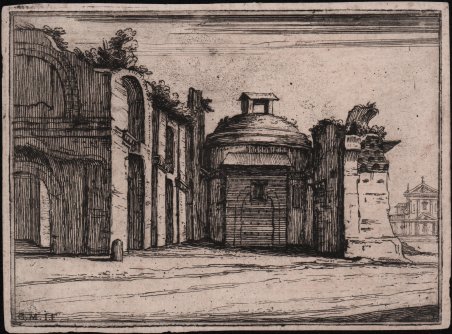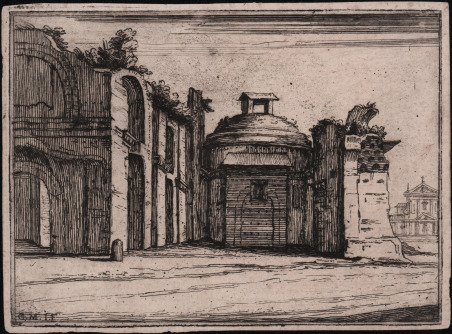Détails
Graveurs
MERCATI Giovanni Battista
Description
PRIMO STATO, SCONOSCIUTO AI REPERTORI Acquaforte, 1629, firmata in lastra in basso. Esemplare di primo stato, avanti il numero 10 e il titolo Listesse Terme aggiunti in alto. Magnifica prova, ricca di toni, impressa su carta vergata coeva, con sottilissimi margini, in perfetto stato di conservazione. La veduta appartiene allâimportante raccolta Alcune vedute et prospettive di luoghi dishabitati di Roma, una serie di 52 incisioni del pittore ed incisore barocco Giovanni Battista Mercati. Bartsch e Rossetti non descrivono queste prove prima della numerazione e del testo. Nel frontespizio della raccolta in nostro possesso â purtroppo non completa delle 52 tavole che per questo motivo vengono offerte individualmente â troviamo in basso a destra lâindicazione del privilegio, il Superior permissu, mentre manca lâiscrizione Cum privilegio Regio che si riscontra in tutti gli altri esemplari della raccolta esaminati, come ad esempio questo del British Museum: https://www.britishmuseum.org/collection/object/P_1868-0822-8618 âIn 1629 Mercati published a series of fifty etched views of Rome which were dedicated to Ferdinand de' Medici. His approach was remarkably innovative. Unlike many earlier view prints of Rome which, like Falda's later ones, emphasized architectural accuracy and were essentially documents and records, Mercati's etchings anticipated Piranesi's more evocative, romantic approach. Mercati's views are delightfully informal, picturesque, and impressionistic. The prints are small and intimate, and the buildings and monuments are often seen from odd points of view. The artist was as concerned with space â empty places (luoghi dishabitati) â and with the light and shadow that fill them as he was with the monuments themselves. His etchings give a vivid sense of the city as it would be glimpsed by someone rambling behind the scenes. Their execution was similarly free and casual, with the etched lines sketchily rendered and stop-out varnish freely and expertly applied to lighten the far distance and to "paint in" bright highlights in the foreground. Especially effective was Mercati's stopping out of a wall seen through the most distant archway, making it look as if its solidity had been bleached away by the sun. The irregular, quivering lines and the intense passages of light and dark give the impression of forms and spaces vibrating in sunlight, flickering with light and shadow. The irregular, frayed quality of the darkest shading lines also evokes the worn, eroded surfaces of the ruins, which seem to be crumbling away before the viewer's eyes. In addition to his knowledge of the etchings of Ventura Salimbeni and Raffaello Schiaminossi, Mercati must also have been aware of similar approaches to views and landscape seen in the prints of Jacques Callot, Stefano della Bella, and Israel Silvestre. In this context it is interesting that Giovanni Battista Falda was strongly influenced by the same three artists, but he assimilated their approach in a way almost the opposite of Mercati's, achieving great clarity and order in the rendering of line and toneâ (cfr. Richard Wallace in Italian Etchers in the Reinassance & Barocque, pp. 160-162). Nato a Sansepolcro in Toscana nel 1591 e morto nel 1645, dopo un apprendistato presso il conterraneo Raffaello Schiaminossi finì col trasferirsi a Roma, che certo offriva più occasioni di lavoro, e fu membro dell'Accademia di San Luca. Autore di qualche disegno noto, di alcuni quadri sacri e di un piccolo manipolo di stampe d'invenzione o di traduzione (da sculture classiche o da dipinti di Correggio e di Pietro da Cortona), risulta in qualche relazione con personaggi della Roma barberiniana, a cui dedica le sue incisioni. Per citarne solo alcuni, Cassiano Dal Pozzo, Marcello Sacchetti, il cardinal nipote Antonio Barberini, Paolo Giordano II Orsini duca di Bracciano, e infine Francesco Borromini. Specialmente strette appaiono le sue amicizie con i toscan.


Découvrez comment utiliser
Découvrez comment utiliser

